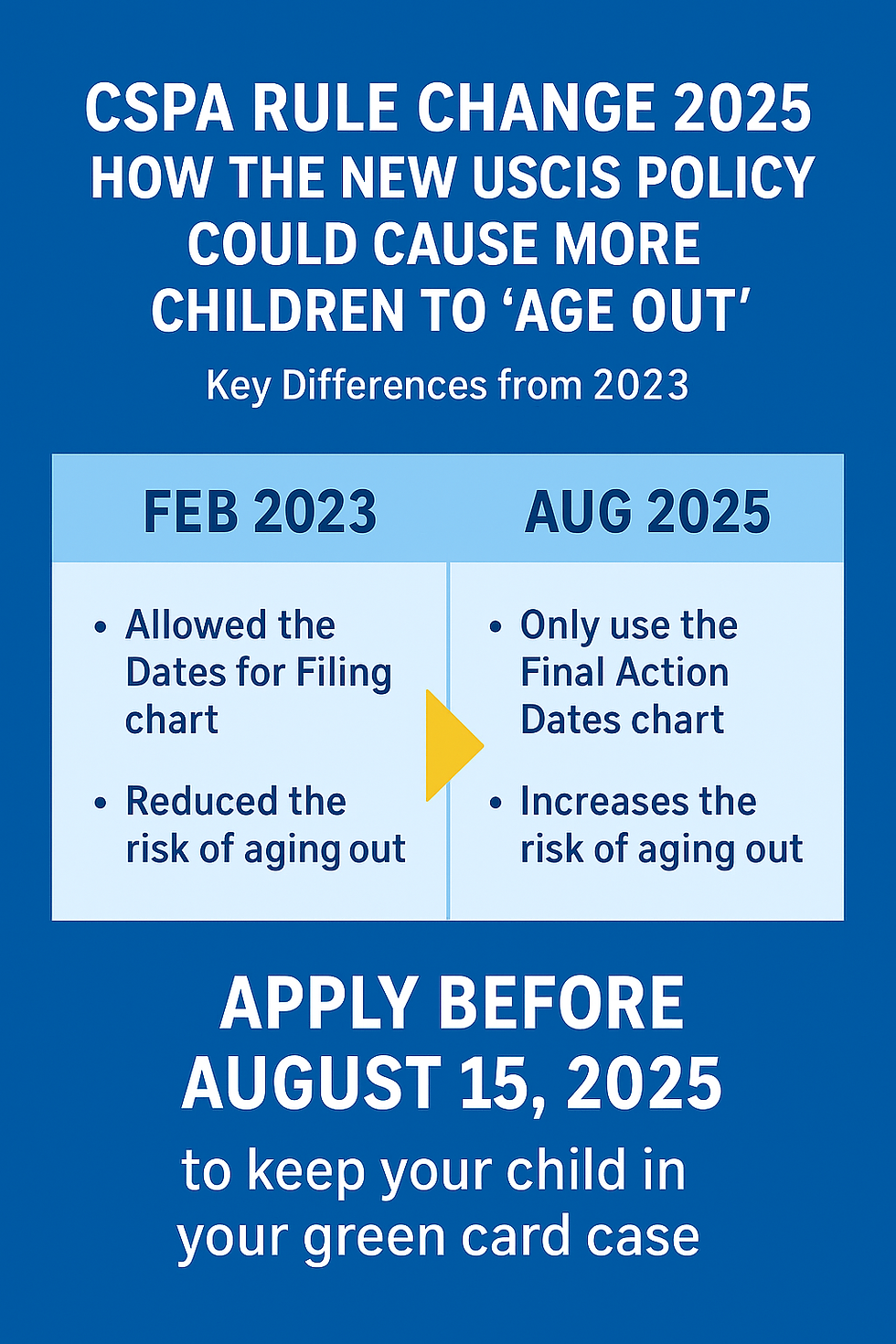CSPA Rule Change August 2025: How the New USCIS Policy Could Cause More Children to ‘Age Out’ – Key Differences from February 2023
- visa code
- Aug 11
- 3 min read
Introduction: Why the Child Status Protection Act (CSPA) Matters
The Child Status Protection Act (CSPA) is a critical U.S. immigration law designed to help children of green card applicants remain eligible even if they turn 21 during long processing delays. Under CSPA, a child’s “immigration age” can be frozen to prevent them from “aging out” of eligibility.
With USCIS’s new CSPA rule effective August 15, 2025, many families especially those from highly backlogged countries like India may face a higher risk of their children aging out. The new USCIS policy on CSPA can be found here.
This article explains:
The February 2023 CSPA policy change
What is being rolled back in August 2025
Who will be affected
What steps families can take to protect their children’s immigration status

1. CSPA Basics: How the Age Freeze Works
Under normal U.S. immigration rules, children must be under 21 years old to qualify as a “child” for green card purposes. The CSPA formula calculates the child’s age as:
Child’s Age at Visa Availability minus Time I-140 or I-130 Was Pending
The tricky part is determining when a visa is “available” and this is where the major policy changes come in.
2. February 14, 2023 CSPA Policy Update – More Protection for Children
In February 2023, USCIS updated its policy to allow the Dates for Filing chart (Chart B of the Visa Bulletin) to be used for CSPA age calculations.
Impact of the 2023 change:
Families could file earlier for Adjustment of Status (Form I-485)
The earlier filing date meant CSPA age froze sooner
Greatly reduced the risk of children “aging out” before green card approval
Benefited thousands of children in family-based and employment-based green card backlogs, particularly EB-2 and EB-3 India
Example: If Chart B showed a visa date available in October, but Chart A (Final Action Dates) was not current until the following year, a child could still lock their age in October under the 2023 policy.
3. August 15, 2025 CSPA Rule Change – Back to Stricter Calculations
Effective August 15, 2025, USCIS will revert to the older, more restrictive interpretation:
Only the Final Action Dates chart (Chart A) can be used to determine when a visa is “available” for CSPA purposes.
The Dates for Filing chart will no longer freeze a child’s immigration age.
What this means:
Families will need to wait longer before filing Adjustment of Status
More children could turn 21 before their CSPA age is locked in
It aligns USCIS with the Department of State’s consular process, which always used Final Action Dates
4. Who Is Affected by the CSPA 2025 Change?
The groups most affected will be:
Employment-based green card applicants from highly backlogged countries (India, China)
Family-based applicants with long wait times
Children who are close to 21 years old when the Final Action Date becomes current
Families who could have filed earlier under Dates for Filing but will now be forced to wait
5. Timeline of CSPA Policy Changes
Period | Chart Used for CSPA Age | Aging-Out Risk |
Before Feb 14, 2023 | Final Action Dates only | High |
Feb 14, 2023 – Aug 14, 2025 | Dates for Filing allowed | Lower |
From Aug 15, 2025 | Final Action Dates only | Higher |
6. How Families Can Protect Their Children from Aging Out
If your child is approaching 21:
File Adjustment of Status before August 15, 2025 if eligible under Dates for Filing
Monitor the Visa Bulletin monthly to track when your category is current
Consider nonimmigrant visas (e.g., F-1 student visa) to maintain legal status if aging out is likely
Explore whether the child can qualify for a separate employment-based petition
7. Key Takeaways
The February 2023 policy gave families extra protection by allowing earlier CSPA age freezes.
The August 2025 policy removes that flexibility, increasing the risk of aging out.
Action before August 15, 2025 could make the difference between keeping a child in your green card case or losing eligibility.
Final Note:
If you think your child is at risk of aging out, consult an experienced U.S. immigration attorney as soon as possible. The CSPA rules are complex, and timing is critical especially now that the 2025 rollback is near.
